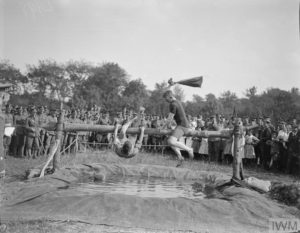Monday September 16th, 1918
Much as usual.
New Battalion Training Programme
Today, the battalion embarks on a new training schedule for the week ending September 21st. This morning A and B companies are completing ‘Firing Platoon Field Practice‘ on A and C ranges. See here for a map of the Brigade’s training grounds. Nearby, others are practicing ‘manoeuvring of the Lewis Guns‘.

This afternoon C and D companies will be rehearsing ‘Gas Drill’ and following ‘Musketry Instruction‘. HQ will practice firing at 200 and 300 yards on A range under the command of two subalterns.
After quinine parade, the officers’ will go to riding school – in training for the Battalion and Brigade sports meetings.
Over the next few days, men of the companies will also be trained in rifle grenades, bayonets, bombs and the tactical handling of Lewis Guns. On Wednesday and Thursday the battalion will be able to use the baths.
The Brigade Sports meeting will be over the weekend, accompanied by the music of the Battalion’s band on Sunday afternoon. The photograph shows soldiers and French civilians watching a pillow fight at the Guards Division Sports at Bavincourt in June 1918.* This clearly shows that not every event at Sports Meetings was about military prowess.
Training the Platoon for Offensive Action, 1917
All this training, cleanliness and exercise is in line with the General Staff’s guidance. ‘All ranks must be trained in the following:-
vi.) Steady drill and ceremonial are necessary to inculcate discipline, of which cleanliness, smartness and steadiness are the bedrock.
vi.) [sic] Bayonet fighting produces lust for blood; much may be accomplished in billets in wet weather, as well as out of doors on fine days.
viii.) Bomb throwing and duties of Moppers up require practice and careful study. Moppers up should work in pairs under their own Commander. They drop into their objective and work laterally outwards. They kill any enemy met with in the trenches and guard the entrances to dugouts and side trenches. They must not penetrate down into the dugouts before the platoon for which they are mopping up arrives.
ix.) Musketry; too much stress cannot be laid on practising the standard tests laid down in Musketry Regulations. These can be practised in billets on wet days just as well as out of doors. Tripods and aim correctors are easily improvised. Good bolt manipulation produced chiefly by the application of the standard tests in the barrack room on wet days, kept the enemy out of our trenches at the beginning of the War, when such luxuries as wire entanglements were not forthcoming. Ranges also are easily improvised.
x.) Physical fitness:—Route marching, physical training and recreational training, such as football, paper-chases, etc., etc. These latter are best carried out on Wednesday and Saturday afternoons, which, if training is progressing satisfactorily, may be half-holidays.’¹
There is no mention in this week’s Programme of Training that the men are getting any half-holidays. Perhaps their training is not going as well as hoped.
9th Battalion War Diary – 16h September 1918 – Haudricourt
Training as per programme (Appendix No 3). 3 OR having rejoined are taken on effective strength 15-9-18. Lt JA Spurling, A Coy, having proceeded to base in accordance with 199th Brigade A806 dated 15-9-18 is struck of the effective strength of the Battalion 16-9-18. 1 OR is struck off effective strength on evacuation to stationary hospital Abancourt 15-9-18 and 1 OR on admission to Auxiliary Hospital Wigan whilst on leave 17-8-18.
References & Further Reading
¹ ‘Instructions for the Training of Platoons for Offensive Action, 1917’ issued by the General Staff. Reproduced in the book, ‘An Officer’s Manual of the Western Front: 1914-1918’ by Stephen Bull, Conway 2014, pages 123/4
* Q 9186, copyright Imperial War Museums


